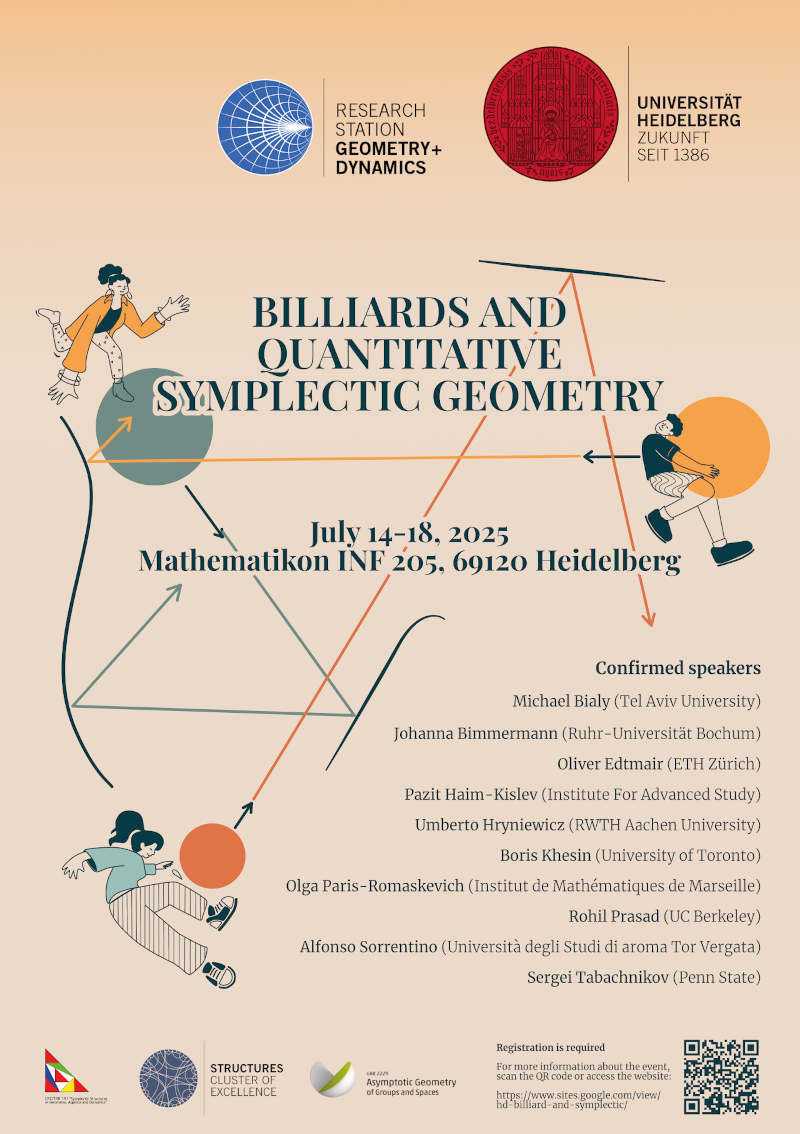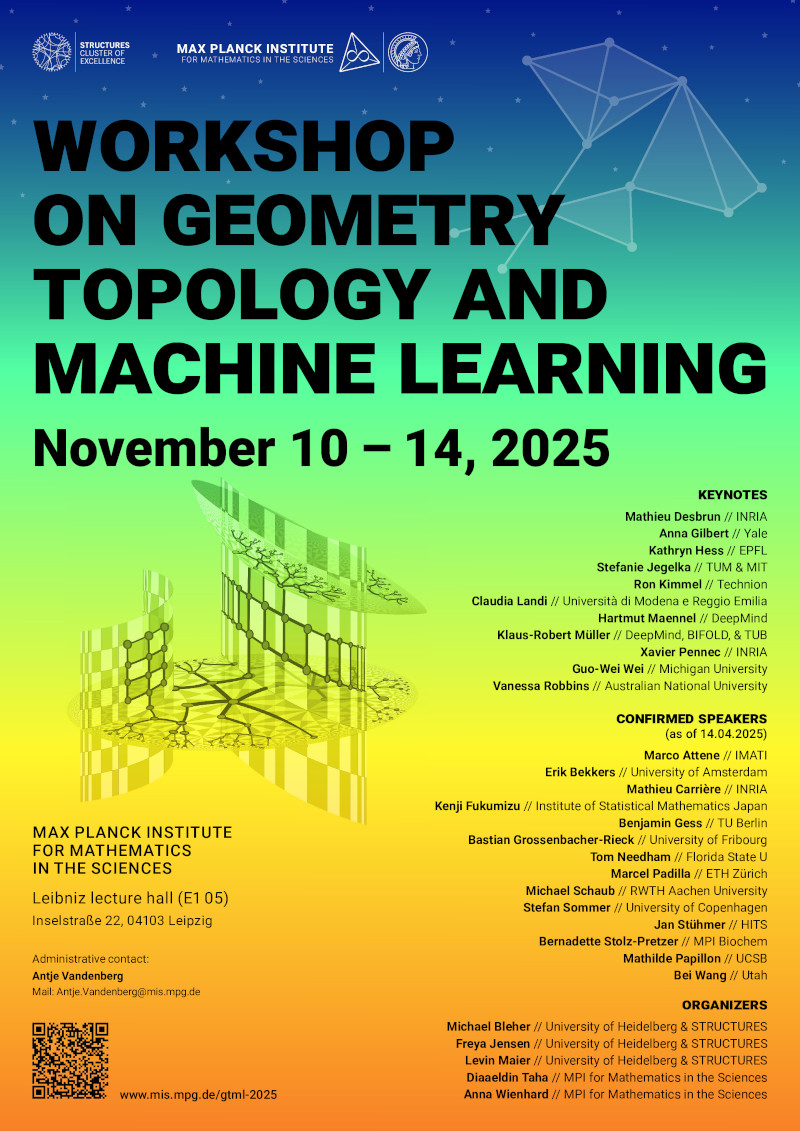Newsroom
Stay informed with our latest news and announcements on this page. For more in-depth content, we also encourage visitors to explore our bimonthly STRUCTURES Newsletter magazine, which features a variety of articles, interviews with members, and background information on our latest research and activities.
We are happy to announce the workshop on Billiards and Quantitative Symplectic Geometry taking place July 14–18 at Heidelberg University, organized in collaboration with Heidelberg's Research Station Geometry + Dynamics. The workshop aims to foster the rich interplay between billiards and symplectic geometry. Billiards, with their deep connections to dynamical systems and geometry, serve as a valuable tool for studying quantitative symplectic geometry. Conversely, symplectic geometry provides the means to define new types of billiards.
Through lectures, discussions, and collaborative sessions, the event encourages the exchange of ideas, bridging these disciplines and inspiring innovative research directions.
When? July 14–18, 2025
Where? 5th floor conference room of the Institute of Mathematics (Mathematikon)
Applications are open until June 15, 2025. More details and the registration form can be found at:
https://sites.google.com/view/hd-billiard-and-symplectic/
The workshop is organized by Ana Chávez Cáliz, Lina Deschamps, and Levin Maier.
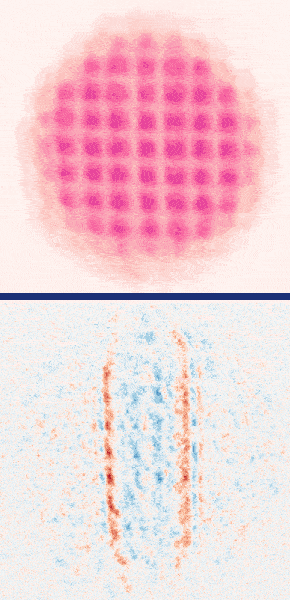
STRUCTURES researchers have uncovered supersolid-like sound modes in a far-from equilibrium quantum gas.
In a new study, experimental physicists from Heidelberg's Kirchhoff Institute for Physics have observed that spontaneously emerging patterns in driven superfluids exhibit properties characteristic of a rare state of matter known as a supersolid. Supersolids are unique because they simultaneously behave like a fluid that can flow without resistance (a superfluid) and a solid with a crystalline structure, meaning particles are both delocalised and arranged in a regular pattern. This duality results from breaking two fundamental symmetries: the U(1) symmetry associated with superfluidity and translational symmetry associated with the periodic structure. A key feature of supersolids is the presence of two distinct types of sound waves, or “sound modes”, connected to the two independently broken symmetries.
Driven systems, which are systems continuously supplied with energy, are of significant scientific interest because they can display unique properties distinct from those at equilibrium, sometimes leading to long-lived states with novel material characteristics. Although these systems are far from equilibrium, in certain cases they can produce ordered stationary states that share physical properties usually attributed to equilibrium systems. This enables the application of mathematical descriptions developed for equilibrium scenarios.
In superfluids, it is known that driving the interaction strength results in stable periodic density structures. However, no previous study has been performed on how sound waves propagate through these patterns. This work demonstrates that the theoretical framework of supersolids (developed for equilibrium systems) can be applied far from equilibrium (in the metastable patterned state), and therefore unites the study of pattern formation with that of supersolids.
The team studied a Bose-Einstein condensate of potassium-39 atoms, periodically driven by modulating the atomic interaction strength. This created stable, periodic density patterns. By probing the state’s response to disturbances, similar to how sound waves are used to study materials, they were able to excite and measure distinct sound modes in this driven quantum gas, whose analysis confirmed that this patterned state behaved like a one-dimensional supersolid, aligning with the hydrodynamic description of “superfluid smectics,” a state of matter that is the superfluid analogue of what is known as a smectic-A liquid crystal phase.
This research, published in Nature Physics, reveals fundamental insights into driven quantum matter, demonstrating that the concept of supersolidity is useful for understanding dynamic and far-from-equilibrium states of matter. Moreover, it establishes the studied Bose-Einstein condensate as a promising platform for exploring other complex phenomena in patterned superfluids, such as topological defects or phase transitions out of equilibrium.
The research was conducted by Nikolas Liebster, Marius Sparn, Elinor Kath, Jelte Duchene, Helmut Strobel, and Markus K. Oberthaler.
Further information:
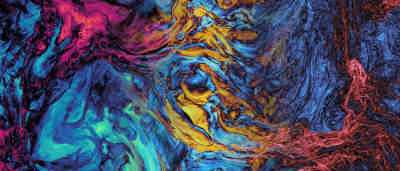
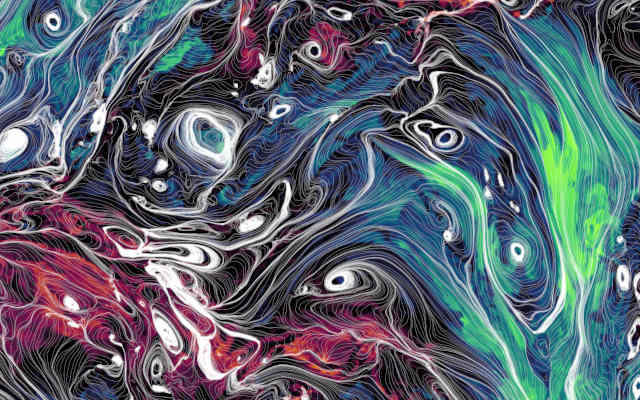
World’s largest simulation of magnetized turbulence reveals major deviations from canonical models.
Groundbreaking simulations led by an international team of researchers, including STRUCTURES member Ralf Klessen (Centre for Astronomy Heidelberg, ZAH, and Interdisciplinary Center for Scientific Computing, IWR) have unveiled previously unknown details about turbulence in the magnetized environment of the interstellar medium (ISM). This complex, turbulent plasma, composed of hot, electrically charged gas and dust between the stars in our galaxy, profoundly influences fundamental cosmic processes such as star formation and cosmic-ray transport. Unlike everyday turbulence, the interstellar medium's plasma is magnetized, making it particularly difficult to observe and model.
The new study, published in Nature Astronomy, utilized simulations with unprecedented grid resolutions to model highly compressible, magnetized turbulence akin to that occurring in the ISM. “This is the first time we can study these phenomena at this level of precision and at these different scales,” says James R. Beattie, the first author of the study. A key finding is the discovery of two distinct, coexisting kinetic energy cascades within the turbulence – a process where kinetic energy flows from large to small scales within the turbulent ISM. The interstellar medium can be envisioned as a fluid with swirling motions of various sizes, powered by energy often injected on large scales (e.g., from exploding stars). According to the new simulations, this energy transfer happens in two separate ways depending on the scale of these motions. On the largest scales, where gas is moving faster than sound (supersonic) and magnetic fields are relatively weak, the energy transfer is more direct and can “jump” across different sizes of swirls. However, on smaller scales, where gas moves slower than sound (subsonic) and is strongly influenced by magnetic fields woven in the ISM, energy flows more gradually down through successive scales. This two-level process of energy dissipation is a significant departure from simpler, older models of turbulence. The team also discovered that energy stored in the magnetic energy itself has its own unique way of cascading through these turbulent regions, following a pattern that current theories do not fully explain.
These findings challenge fundamental theories of magnetohydrodynamic (MHD) turbulence and provide crucial insights into the properties of the ISM. In particular, they help to explain how turbulence affects the initial conditions for star formation. Whereas the coupling of turbulence and magnetic fields enhances filamentary structures along which stars preferentially form, the strong magnetic influence on smaller scales acts like a form of pressure that can help support gas clouds against gravitational collapse – suppressing the rate of star formation at the same time. The simulations used over 80 million CPU hours on nearly 140,000 cores of the SuperMUC-NG supercomputer at the Leibniz Supercomputing Centre.
Further information:
- Original Publication: Beattie, J.R., Federrath, C., Klessen, R.S. et al. The spectrum of magnetized turbulence in the interstellar medium. Nat Astron, 2025 (Link to Nature Astronomy)
- Research homepage of Prof. Ralf Klessen
Persistent Seminar – a Biweekly Forum on Persistent Homology, Computational Algebraic Topology & Applications (Start: May 14)
We are happy to announce the start of this semester's Persistent Seminar – a biweekly forum on persistent homology, computational algebraic topology and its applications. The new seminar format replaces the previous journal club on Topological Data Analysis. The kick-off session takes place on May 14 with an organizational slot and an inaugural talk by Freya Jensen (Interdisciplinary Center for Scientific Computing, IWR) on “Persistent Spectral Sequences and Where to Find Them.” Anyone is welcome who wishes to exchange about open problems, preprints, new ideas or is just curious about Topological Data Analysis.
Topological Data Analysis (TDA) is a recent development in mathematics and data analysis that offers versatile tools to uncover potentially hidden topological structures in data. The basic idea is using a homology theory – called persistent homology – to unveil and identify structures in data via a notion of its topology. However, interpreting these structures is by no means an easy task, and depends on the specific details of the underlying system. Within STRUCTURES, the EP Mathematics and Data provides a platform across the fields of the natural sciences and mathematics to discuss applications and foundations of TDA and beyond.
Further information:
- Where and When: Mathematikon SR 00.200, Wednesdays 14‑16 h, every other week
- Contact: Freya Jensen (IWR)
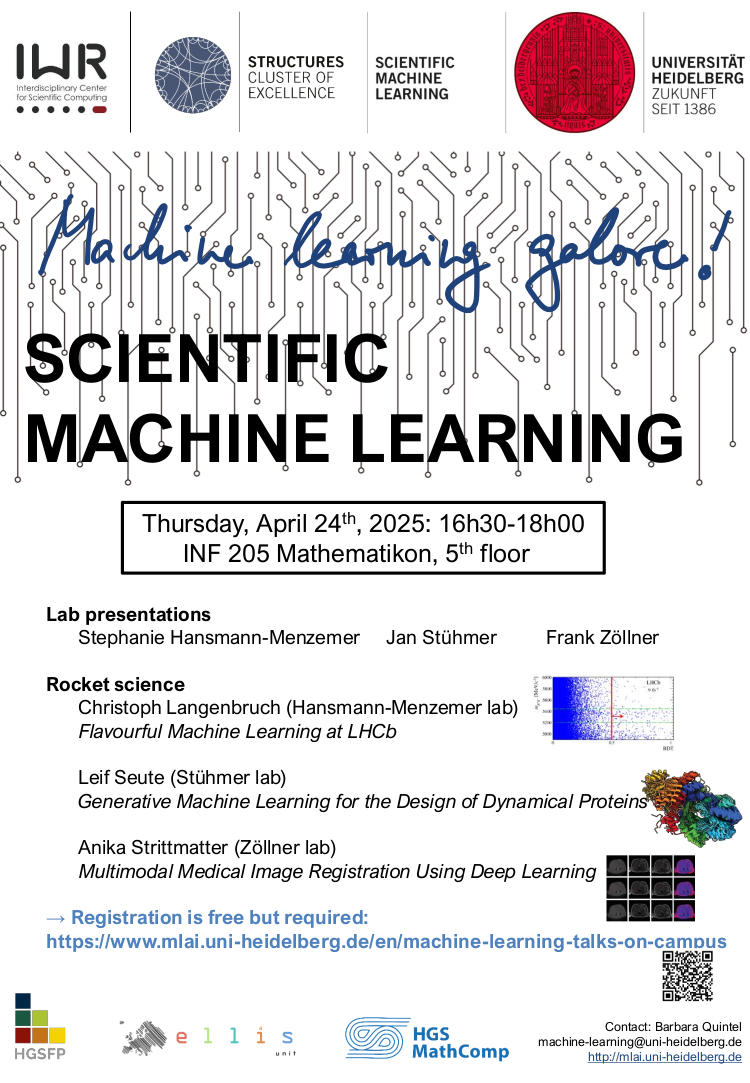

We are delighted to announce the next event in our Machine Learning Galore! series, focusing on Scientific Machine Learning, which will take place on Thursday, April 24, from 4:30 to 6:00 pm at INF 205 Mathematikon (5th floor). The event will feature lab presentations by principal investigators, followed by brief presentations from junior scientists showcasing their latest work. Extended discussions will offer ample opportunity for in-depth exchanges.
In order to participate, please register for free at the ML-AI portal by April 22.
Event Details:
- Lab presentations:
- Stephanie Hansmann-Menzemer
- Jan Stühmer
- Frank Zöllner
- Science Talks:
- Christoph Langenbruch (Hansmann-Menzemer lab): Flavourful Machine Learning at LHCb
- Leif Seute (Stühmer lab) Generative Machine Learning for the Design of Dynamical Proteins
- Anika Strittmatter (Zöllner lab) Multimodal Medical Image Registration Using Deep Learning
About Scientific Machine Learning
Scientific Machine Learning is a collaborative initiative by the Interdisciplinary Center for Scientific Computing (IWR) and the STRUCTURES Cluster of Excellence. Its mission is to foster interaction and exchange within the local machine learning community, and to support its development by consolidating activities and resources that might otherwise remain scattered across individual institutions or disciplines. The initiative aligns closely with the objectives of STRUCTURES, which aims to advance fundamental research, and with IWR’s focus on applying machine learning to address long-standing challenges in the natural and life sciences, engineering, and the humanities.
Further information:
We are pleased to announce the workshop Geometry, Topology and Machine Learning (GTML), jointly organized by the Max Planck Institute for Mathematics in the Sciences and the STRUCTURES Cluster of Excellence. The event, taking place from November 10 to 14, 2025, will bring together two rapidly evolving fields central to modern machine learning. Geometry and topology offer fundamental methods for understanding data structure and provide powerful frameworks for analyzing, unifying, and generalizing machine learning techniques across diverse applications.
The workshop will feature 10 keynote talks and 20 presentations by leading experts. Topics range from mathematical foundations of machine learning to geometric & topological deep learning, as well as multidisciplinary applications of geometry & topology. By merging the previous Workshop on Geometry in Machine Learning (GaML) and the Workshop on Topological Methods in Data Analysis (TMDA), GTML creates a platform to foster collaboration and to explore the synergistic relationship between geometry, topology, and machine learning.
For further details, including an overview of talks and speakers, and to register, please visit:
https://www.mis.mpg.de/events/series/workshop-on-geometry-topology-and-machine-learning-gtml-2025
Applications for lightning talks can be submitted via the registration form by May 31, 2025.
Further information:

Heidelberg University is set to pioneer a transformative approach to mathematics education with the launch of its new master’s programme, “Mathematics of Machine Learning and Data Science.” Starting in the winter term 2025/2026, the new research-oriented course aims to lay the mathematical and methodological groundwork that will enable future generations of mathematicians to advance the frontiers of machine learning and scientific data analysis. The programme, which is taught in English, is based in the Faculty of Mathematics and Computer Science and coordinated by the Institute for Mathematics in cooperation with the Interdisciplinary Center for Scientific Computing. Prospective students are encouraged to apply by the deadline of 15 May 2025.
“Machine learning and data science are currently revolutionizing the sciences. This equally concerns basic research to better understand established methods, such as the learning-based analysis of data, as well as projects to apply these methods in by now almost all branches of science,” underlines Prof. Dr Christoph Schnörr from the Institute for Mathematics of Heidelberg University. This is where the new four-semester master's programme starts: it imparts an advanced understanding of how pure and applied mathematics intersect to innovatively expand on the methodology of machine learning and scientific data analysis. By integrating core areas such as topology, differential geometry, dynamic systems, statistics, optimization, numerics, and functional analysis, the curriculum creates a robust framework for developing novel methodologies. “Compared to the regular mathematics master’s, this programme is extremely interdisciplinary in approach. We see this, for example, in the lecture series for the first semester, which gives a broad overview of core fields of mathematics,” says Prof. Schnörr.
Students will gain practical experience by working on the implementation and application of theoretical models in a data science lab, and acquire core competences analytical & structural thinking, scientific problem-solving and interdisciplinary collaboration. The option to spend a semester abroad offers valuable opportunities to engage in international teamwork and collaborate with leading researchers worldwide. Additionally, specialization modules extending over the two years will prepare the students for their master’s thesis and equip the graduates for doctoral positions in Germany and abroad, as well as for research-oriented work in industry.
Further information:

